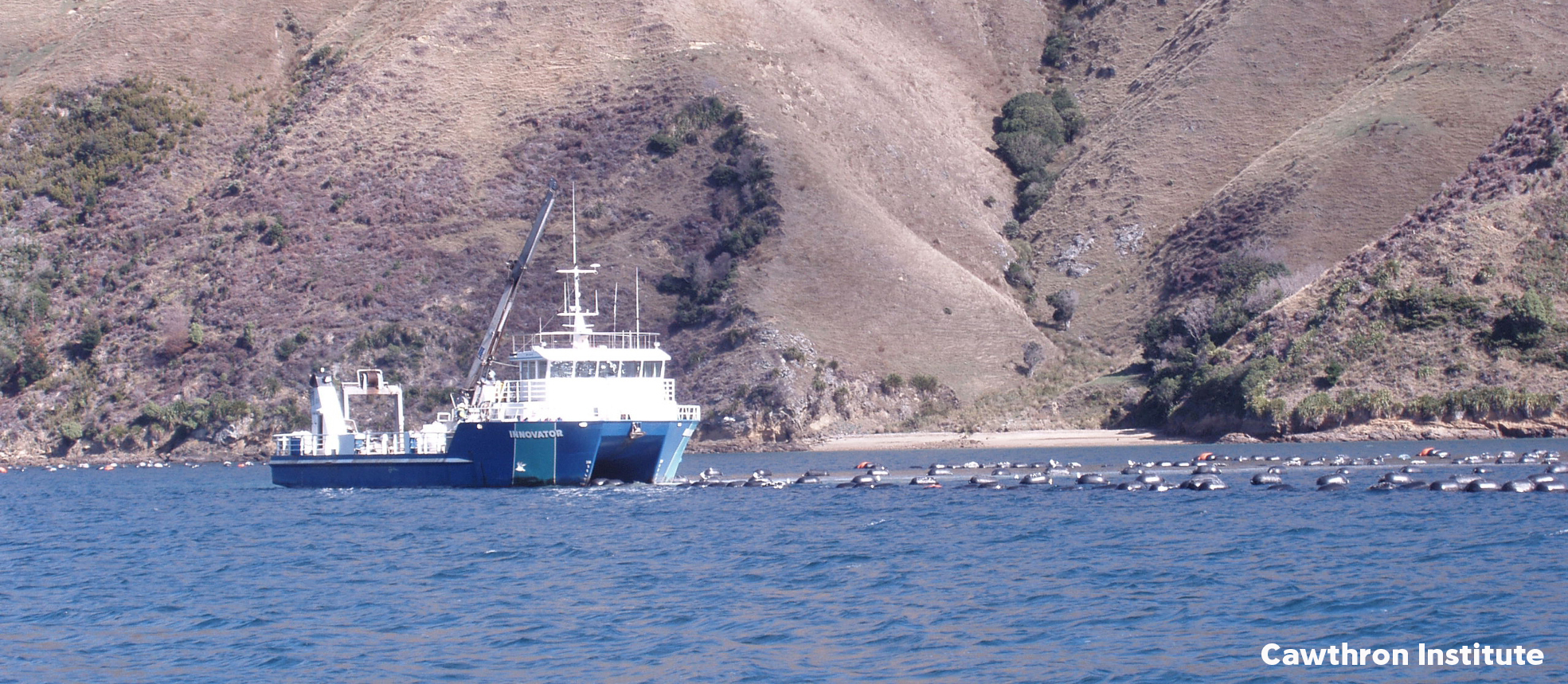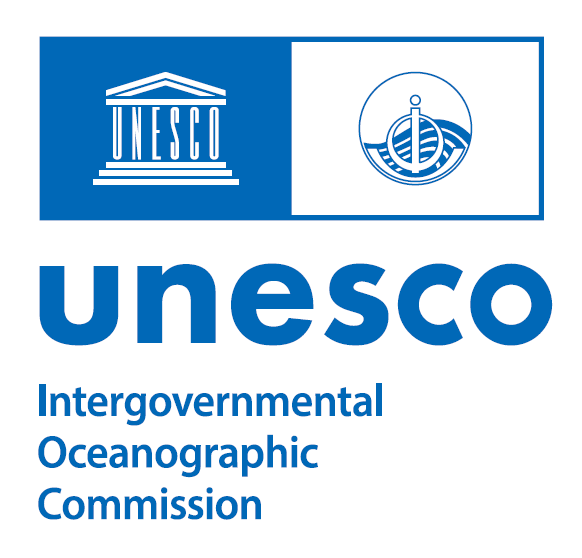Overall objective: To determine the link between marine aquaculture and HAB occurrence in different regions and to find efficient methods to protect farmed seafood products from HABs impacts.

Mussel harvester, Marlborough Sounds, New Zealand. Photo: Cawthron Institute..
Rationale. Fin-fish, shellfish, crustaceans and macroalgae aquaculture has many benefits, including the production of nutritious high-protein food, reducing the pressure on natural resources and supporting sustainable economic development and employment. In some countries, marine aquaculture is an important contributor to the national economy and future projections suggest there will be large increases in global production in coming decades.
Nevertheless, for a variety of reasons, aquaculture operations (particularly sea-cage fin-fish rearing) in coastal waters are frequently controversial. Because the improved awareness and identification of HAB events has occurred alongside growth in aquaculture, a plausible hypothesis is that these developments have increased the frequency and intensity of HABs. In some situations the transfer of aquaculture equipment and cultured organisms may facilitate HAB species dissemination (Hegaret et al. 2008). However, with respect to fin-fish farming, a more common concern is that the additive effect of numerous closely sited farms discharging large nutrient loads into coastal waters may cause eutrophication, or shifts in macro-nutrient ratios, that enhance the potential for the generation of high-biomass or toxic species-dominated HABs (e.g., Buschmann et al. 2009). Although links between HABs and coastal eutrophication (Heisler et al. 2008) exist in some situations, the scientific literature on the impact of fish farming provides a much more equivocal point of view. For example most empirical evidence (e.g., Gowen et al. 2012; Price et al. 2015) suggests that in many situations it is difficult to directly attribute a significant response by phytoplankton in general, let alone harmful species, to water nutrient enrichment due to discharges from sea cage operations.
The perception that fin-fish aquaculture (and perhaps shellfish and macro-algae aquaculture) leads to increased problems with HABs is an important planning question, on which it is difficult to confidently provide an expert opinion in the absence of long-term time-series data on biological and physical parameters and appropriate modelling expertise to simulate potential impacts. This uncertainty may permit unsustainable developments or constrain otherwise environmentally acceptable enterprises. An increased scientific focus on this topic is needed to inform industry, ensure that coastal resource managers have the best available information, and to provide new protocols and technologies for better evaluating the impact of aquaculture on the water column.
Biophysical modelling is useful to simulate the spatial and temporal response of harmful phytoplankton (Anderson et al. 2005) to environmental forcing factors, especially when combined with satellite remote sensing data (Anderson et al. 2016; Davidson et al. 2016; Ruiz-Villarreal et al. 2016). These approaches have been successful in providing real-time predictions that have been incorporated into national forecasting systems for public health and aquaculture protection. They have been most effective when focused on large-scale events in extensive offshore-coastal ecosystems (e.g., Gulf of Maine, Coastal California, the Western European seaboard), but in many aquaculture contexts HABs are most problematic in nearshore semi-enclosed waters caused by resident toxic algae populations. Improved bloom simulation models that incorporate complex growth and life cycle behaviours and bloom termination factors (e.g., nutrient limitation, zooplankton grazing and disease) in these situations are needed.
Phycotoxin contamination and mass mortalities of cultured animals caused by HABs can have devastating impacts on aquaculture operations. Although conventional monitoring methods successfully protect bivalve aquaculture from harvesting toxic shellfish, the costs of routine sample collection and analysis are high and improved surveillance and prediction methods are required. Blooms of a variety of micro-algae (raphidophytes, dictyophytes, haptophytes, dinophytes) continue to cause substantial losses to sea-cage fish-rearing operations (Clément et al. 2016) and early warning methods have yet to be perfected. Importantly, considerable uncertainty remains about the mechanisms of action of most fish-killing algae, which is a major impediment to the development of antidotes and mitigation measures. Also within this context, new toxic compounds produced by micro-algae are being discovered that may have hitherto unrecognised effects on cultured marine species (e.g., Borcier et al. 2017).
Autonomous in situ molecular and imaging flow cytometry methods have proved capable of real-time sensing of impending blooms (e.g., Campbell et al. 2010), but require further refinement and field trials. Rapid test kits using a variety of technologies for the detection of organisms and toxins in waters and shellfish are becoming increasingly available, although further method development, a wider range of targets, and validation studies are needed. These are important fields of applied research that require continued effort to provide reliable, mature, cost-effective solutions that can be used in real-world aquaculture situations.
Specific objectives:
- Encourage research on the potential effects of nutrients, shifting nutrient ratios, and dissolved and particulate organic matter from aquaculture in promoting HABs.
- Comprehensively review evidence for link(s) between aquaculture and the promotion of HABs in different regions.
- Foster international collaboration on the development and field trial of new technologies for aquaculture, for the monitoring, forecasting and mitigation of HABs.
Example tasks
- Facilitate collaboration between local, regional and international organizations (e.g., PICES, ICES) and relevant end users (local environmental regulators and the aquaculture industry) to jointly investigate the links between HABs and aquaculture.
- An international workshop on the mechanism of toxicity of fish-killing HABs and methods for mitigating their effects in coordination with the ICES Working Group on fish-killing algae in the North Atlantic and the IOC Task Team on fish-killing algae.
- Through project endorsement assist researchers with international technology transfer, validation and field trials of innovative monitoring methods (e.g., autonomous in situ technologies and new mass spectrometry analytical methods).
Outcomes
- A special journal issue (or a stand-alone volume) including a series of scientific papers examining the evidence for links between aquaculture and HABs in regions (e.g., Chile, Norway, Scotland, Ireland, U.S./Canada, Japan, Korea, China, Vietnam, Thailand, Australia, New Zealand, etc.) with significant coastal caged-fish farming industries.
- A better understanding of the potential and real impacts of HABs will provide tools for improved management of aquaculture resources and practices to prevent negative effects.
- INFORMATION FOR POLICY MAKERS:
- Guidelines for the optimum location and nutrient loading rates for aquaculture to minimize the risk of HABs.
- An evidence-based perspective and resource for authorities responsible for granting access to the utilization of coastal water space.
- Independent scientific advice to seafood regulators and industry on the efficacy of alternative monitoring and mitigation methods for the maintenance of food security and international market access for aquaculture products.
References
The complete list of references can be found here.


